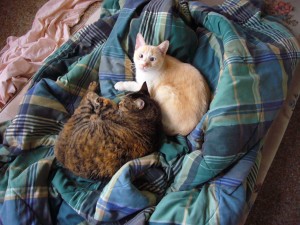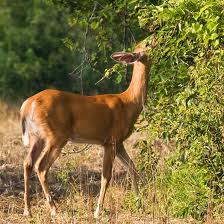 There is such a thing as a free lunch, or almost free: The edible wild plants around you.
There is such a thing as a free lunch, or almost free: The edible wild plants around you.
With a little specialized knowledge and a “guidance” system you can learn to spot edible plants where you live, even in a city. You can do it on your own but it’s better to learn from someone showing you the way. I’m confident you can do it. You only need to learn about a few plants, not every plant you see. And I’ll also tell you where you can learn from a teacher, usually for free.
So let’s get started. You need to know something about foraging, and something about wild plants. Plants are really easy to tell apart. In this blog you’ll read about how to think like a forager. Remember, you’re not trying to learn all of botany or name every plant you see, just the tasty edibles in your area. There are over 120,000 edible plants world wide. About one thousandth of those end up in markets. Of those, about 30 of those are used the most. You’ll be looking for a couple dozen of edible plants in your area that are not in local markets, and they are easy to learn.
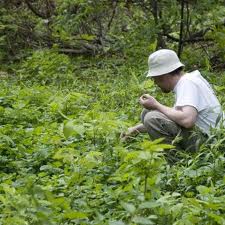 Let’s start with the main rule: Never, ever eat a wild plant without checking with a local expert. Where do you find a local expert, and is there a cost? You can locate a local expert through your local Native Plant Society online or in the phone book. There are chapters in most major cities. You’ll find them throughout the United States and Canada. Plant people are always happy to share knowledge and it’s usually free. They’re passionate about plants, particularly native local ones. You can go on “field trips” and learn from someone who knows what they are talking about. It’s hard to build confidence unless you are studying with someone who is willing to eat the plant in front of you. It is not impossible to learn foraging from books and websites, but it is more difficult and more dangerous. If there isn’t a Native Plant Society near you ask your local librarian: They usually know the main plant person in your area.
Let’s start with the main rule: Never, ever eat a wild plant without checking with a local expert. Where do you find a local expert, and is there a cost? You can locate a local expert through your local Native Plant Society online or in the phone book. There are chapters in most major cities. You’ll find them throughout the United States and Canada. Plant people are always happy to share knowledge and it’s usually free. They’re passionate about plants, particularly native local ones. You can go on “field trips” and learn from someone who knows what they are talking about. It’s hard to build confidence unless you are studying with someone who is willing to eat the plant in front of you. It is not impossible to learn foraging from books and websites, but it is more difficult and more dangerous. If there isn’t a Native Plant Society near you ask your local librarian: They usually know the main plant person in your area.
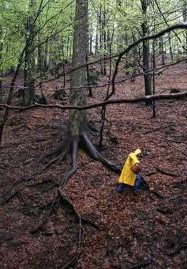 The second rule is even after you have the right wild plant — the expert agrees —and it is edible and you have “itemized” it, only try a little. You may like it but it may not like you. Read my blog on Gallberry and Ilex Vomitoria. Yeah. vomitoria… means what you think it means. Most edible wild plants never made it into the mainstream vegetable market in the United States for a reason (though many of them may be common fare in other countries. Purslane is a prime example.) You don’t know if you’ll have a reaction to a particular plant. I am definitely not a person who has allergies, but there are one or two wild plants that just don’t agree with me even though I like them. So, take it easy first.
The second rule is even after you have the right wild plant — the expert agrees —and it is edible and you have “itemized” it, only try a little. You may like it but it may not like you. Read my blog on Gallberry and Ilex Vomitoria. Yeah. vomitoria… means what you think it means. Most edible wild plants never made it into the mainstream vegetable market in the United States for a reason (though many of them may be common fare in other countries. Purslane is a prime example.) You don’t know if you’ll have a reaction to a particular plant. I am definitely not a person who has allergies, but there are one or two wild plants that just don’t agree with me even though I like them. So, take it easy first.
In fact, it is good advice to never eat a wild plant in the first week you find it. Even among experienced forages there is a strong temptation to make the plant fit the description. I had a friend do that with illness consequences. It’s best to separate the identification and the consumption by a good amount of time. And of course, try only a little the first few times. And learn from an expert.
As for a system….
Every time you or anyone is looking at a plant that might be edible, you need to “itemize” it, put it through four major steps (even the experienced should do it.) I use the word I.T.E.M. to remember what needs to be check out. It’s handy reference and is used in profiling most of the plants on this site.
So, let’s look at the word I.T.E.M.
First, it means (I)dentify the plant beyond doubt. Next, make sure it is growing or fruiting or otherwise available at the right (T)ime of year. Third is checking out the (E)nvironment. This involves two things. One is making sure it is growing in the right place. The other is making sure the plant is getting clean water and is not in polluted soil. And then, what is the proper (M)ethod of preparation. I’m sure you can do that. I.T.E.M. You can rearrange the letters to spell T.I.M.E. if you like as long as you always remember to apply the four steps.
You’ll learn more about I.T.E.M in a moment, but think of it as four obstacles you must eliminate. And you can’t eat a plant until you have gotten rid of those four obstacles. If at any time one or more of them are in the way, that’s a warning sign. If you can’t resolve even one of the warning signs the plant is not eaten. A warning sign does not automatically mean the plant is inedible. But, it does mean you have to do more investigating and get rid of that obstacle before you can consider the plant consumable.
First is “I” identification.
You absolutely must identify the plant correctly, and that involves more than just comparing pictures. This site is NOT to be used for identification. This is site a guide to familiarize you with a particular plant. Identification is a botanical specialty and requires more specific information than appears in these pages. It is learning the physical characteristics of that plant. The best and quickest way is with a local expert and a good identification book used in tandem. There are several reasons for this.
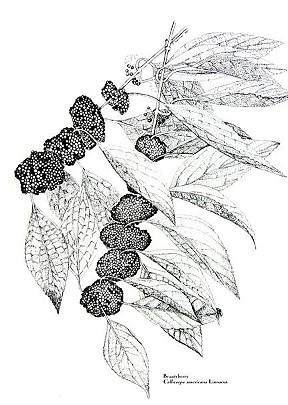 Pictures often don’t tell the entire story, one reason why illustrations of key points are still used. Also, in some areas of the country a plant will look exactly like the picture or illustration in the guide book but in other areas it will not but some other plant might — a non-edible. It is one thing to know a plant in your area is edible. What’s more important is to know what it usually looks like in your area and to identify it absolutely.
Pictures often don’t tell the entire story, one reason why illustrations of key points are still used. Also, in some areas of the country a plant will look exactly like the picture or illustration in the guide book but in other areas it will not but some other plant might — a non-edible. It is one thing to know a plant in your area is edible. What’s more important is to know what it usually looks like in your area and to identify it absolutely.
I forage in Florida, Maine, and Greece, which are all very different climates. In temperate Maine, the plants are usually identification book perfect. Foraging where there is an actual winter is very easy because the plants consistently look the way they are suppose to look. The closer you get to the equator the more difficult it becomes. In Florida plants are often very different because the extreme environmental changes can make plants look far removed from their published examples. Periods of excess water and periods of excess heat change their shape and often where they grow. There can be a lot of subspecies. And in Greece the plants are just different altogether. They look familiar and unfamiliar at the same time.
Often your local plant can be a bad brother of the one in the guide book, or a close cousin, so it may look only a little different or have different characteristics, such as not being edible. Each plant is a little chemical factory, and one tiny change can make a big difference in the chemicals it makes and affect its edibility. Getting the identification right is crucial. I had a friend, who did not study with me, who call one day about a plant he had been eating — identified via a picture. He wanted to know about its berries. The plant he named didn’t have berries, and I knew immediately what he had done and which plants he had mixed up. He had misidentified a plant and was eating one that had some toxicity because he was not preparing it the right way. He had been wondering why his family had been experiencing bad headaches after eating the plant.
There is actually a little more to that incident. The plant he misidentified is one that experts are split on, some report it is edible if prepared correctly others saying it is not edible at all. On the other hand, I now know that plant can be prepared incorrectly, eaten and survived with just a headache. That suggests with proper preparation it is edible.
Identification is important when you know what you’re doing, and even more important when you don’t. That said, don’t be intimidated by the idea of identifying plants. Humans were passing along the knowledge of edible plants long before writing or botany was invented. You’ll come to recognize plants and trust your judgment.
Regardless of how you know a plant is edible you must know it with errorless certainty. That means you have found it many times, prepared it many times, eaten it many times and every time you see it anew you make sure it is the right plant. It is one thing to be wrong and endure all that entails by yourself, it is another to be wrong and have people get sick over it. It is wise always to cross reference what you read. There is a plant in central Florida which only takes one pea-size seed to kill you, though it will take several painful days to do so and there is no antidote. Two reports, however, say that it is edible after cooking. That brings me to the advice of a fellow you will read about in these pages. His was a forager named Dick Deuerling. When told a plant he thought was not edible was edible he would say this: “Invite me over, let me watch you harvest it, let me watch you prepare it, let me watch you cook it and let me watch you eat it. I’ll come back the next day and if you’re still alive I might try it.” My point is you can’t be wrong, so work hard at making it right.
Next in the word in I.T.E.M is “T” time of year.
If your plant is supposed to be flowering in September and you see it flowering in June, you might have the wrong plant, and a good look alike. That of course depends upon where you live. Some plants that bloom or fruit once a year in a northern climate may do so twice in a warmer climate. As an example, my pyracantha fruits twice. Read the blog on Firethorn Jelly. If a plant is not doing what it is supposed to be doing at the right time of year, you need to answer why, which is another reasons to study with a local expert. And let me add that studying is fun. You usually just join in with a group of plant people as they visit a field or forest. Sometimes those field trips are only a few hundred feel long because there’s a world of plants to look at and the experts are more than happy to share what they know with you. They are pleasant people. The point is, if you ask around you will find someone who knows about wild edibles in your area who is willing to share. I’ve even been the botany lesson of the month for several home schoolers. With the help of local experts you can learn the local plants and how they (usually) differ from the text books.
The next step in the general approach has two parts: “E” Environment. The first part is to make sure the plant is growing in the right environment. If the plant likes its feet wet and it is growing in a sand trap you might have the wrong plant. Some plants can tolerate extreme changes in their environment but usually they have a significant preference. Another possible answer is the sand trap may flood often enough to have a bog plant growing there. Or, it might be an overwatered lawn. Here in Florida we have seasonal lakes with cactus. When the plant is in the wrong environment, you have to answer why. It could be you have the wrong plant, or a varying environmental condition. Again, learning from a local expert will get you that specialized knowledge because they have seen it before.
The second part of the environment is checking the area for pollution of the water, soil or air. You don’t want to eat an aquatic plant in a pond that has parking lot run off — a very common issue here in Florida. You don’t want a plant that is growing in the cracked tar of a parking lot. Plants growing down hill from a major highway are suspect, or on a golf course where pesticides are used, or your neighbor’s lawn for that matter or an inner city park. It’s a matter of common sense, but in reality deciding whether a plant is in good soil and getting clean water it is the greatest challenge facing a forager especially in an urban area. Compared to that, identifying plants is relatively easy. (Incidentally, the most common accidental plant poisoning is kids eating landscape plants in your yard, next is eating landscape plants in your neighbor’s yard.)
The next word in the I.T.E.M. system is “M” Method of preparation. Many wild edible require particular methods of preparation to make them edible. Sometimes those methods kept that plant from entering the mainstream food supply. Pokeweed is a good example. It must be boiled at least twice, if not three times. If you boil it once like many other greens you might get ill from it. Despite several efforts in the United States to get that plant into the food supply the need to boil pokeweed more than once kept it out. Another plant may need to be soaked in salty water, or peeled. Some tubers have to be cooked twice. Method of preparation is important. Know it.
I.T.E.M. is the word to always keep in mind whenever you are foraging. You should use it always no matter how much you know about edible wild plants. It’s a system to keep you healthy and happy as a forager. There six other little guidelines to help you later on but I’ll share them with you now and remind you later.
The first one is if it looks like a mint and smells like a mint it is a mint and is edible. But, it must do both. If it looks like a mint but does not smell like a mint, don’t eat it. If it smells like a mint but does not look like one, don’t eat it. What does a mint look like? You’ll learn that later.
This same rule applies to garlic and onions. If it looks like a garlic and smells like a garlic it is a garlic. If it looks like and onion and smells like an onion it is an onion. But both elements must be present. Here in Florida we have a plant which before blossoming looks just like a garlic, even has a bulb, but NO garlic odor. It can make you very sick if not kill you.
The fourth guideline you’ll learn in this blog is that almost all plants with white sap are NOT edible. There are some exceptions and you will learn those along the way. White sap is a huge warning sign a plant is not edible. As for white berries, 99.9999 percent of those are indeed toxic. Don’t eat them. I know of one exception and it is geographically very isolated.
The fifth rule is real short: All mustards are edible. Some taste better than others, or are more digestible than others, but all mustards are edible.
The sixth one is that all mallows are edible in some way except cotton (excluding refined cottonseed oil.) It will vary which part of the mallow is edible, but other than cotton, mallows are edible in some way.
In the various blogs you will learn about specific plants. The blogs on this site are not about plant identification but about the plant, its history, and uses. For exact identification you need a manual. The green and blue boxes on this site about plants are just general descriptions. You should have more exacting ones if you indeed intend to eat or use wild plants. Read the stories behind the edible plants on this site. You probably have the plants, or a local version near you including cactus. If you have any questions, email me.
You can easily and safely learn to forage, and there is a world of plants to explore and enjoy. Reading blogs like this, and identification books, and visiting other sites, is a way to get started. But the greatest peace of mind and the quickest success is to study with an expert. It is one thing to read a plant is edible. It is another to see the person in front of you identify it AND eat it. Watching someone put something in their mouth where their words were builds trust, trust and knowledge builds your personal confidence. It allows you to say with certainty that you know this plant IS edible and you don’t know if that one is. When foraging with others people will ask about this or that plant and if you don’t know, and most plants you won’t know, tell them so. If you’re honest with yourself regarding what you know and don’t know, you’ll be honest with them and mistakes can be avoided.
Lastly, on nearly every page you will find Green Deane’s “itemized” Plant Profile, as below. It is a general guide, especially regarding identification. For certain identification refer to publications that specialize in identification. There will also occasionally be an herb blurb, about reported herbal uses of the plant.




